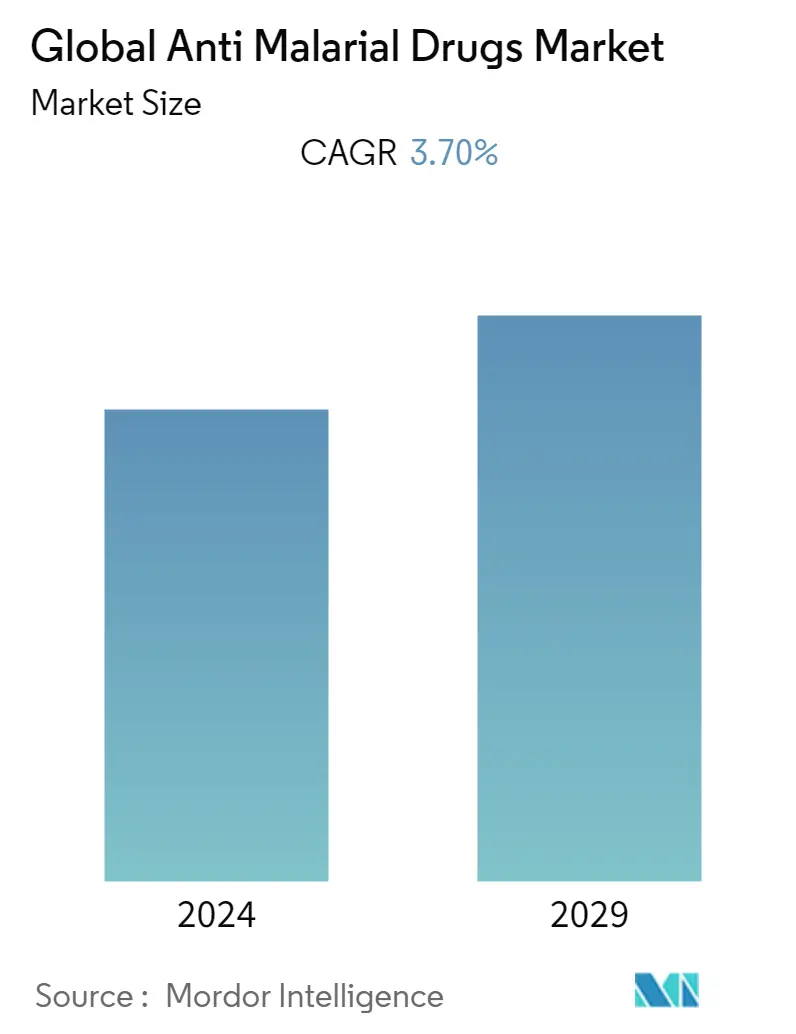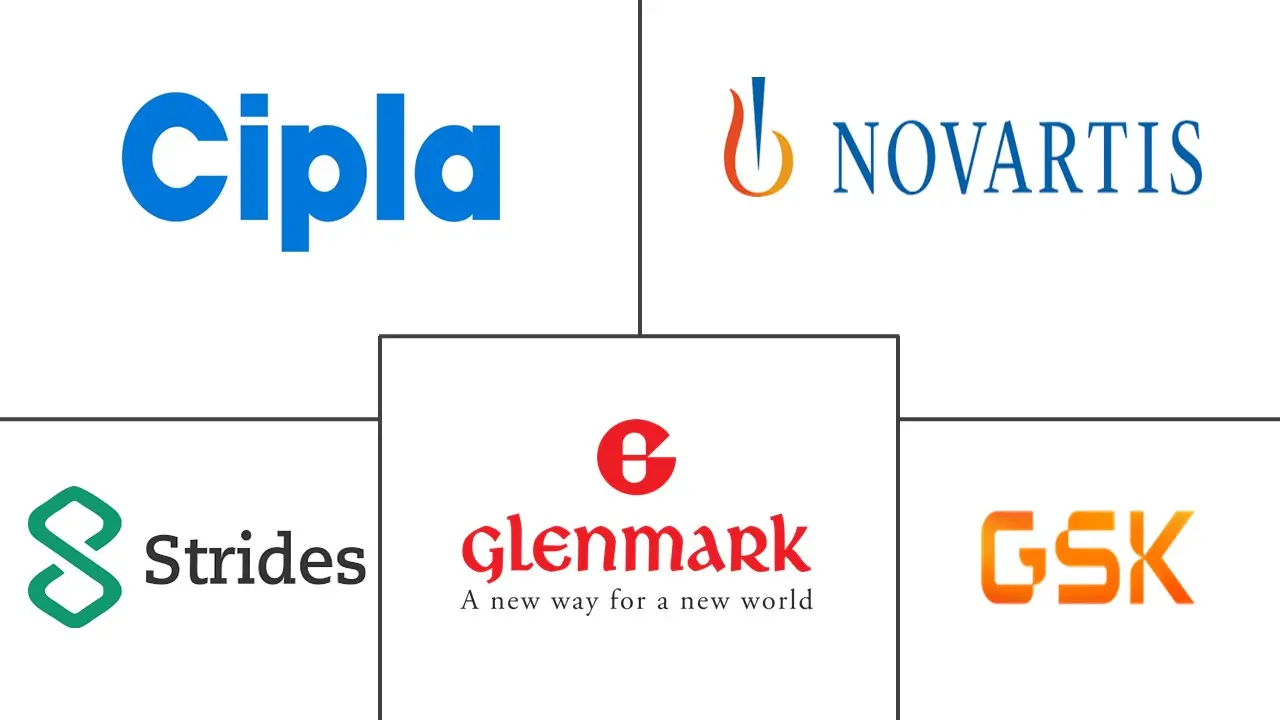Market Size of Global Anti Malarial Drugs Industry

| Study Period | 2019 - 2029 |
| Base Year For Estimation | 2023 |
| Forecast Data Period | 2024 - 2029 |
| CAGR | 3.70 % |
| Fastest Growing Market | Asia Pacific |
| Largest Market | Middle-East and Africa |
Major Players
*Disclaimer: Major Players sorted in no particular order |
Anti Malarial Drugs Market Analysis
The Anti Malarial Drugs market is expected to register a CAGR of 3.7% over the forecast period (2022-2027).
COVID-19 has dramatically impacted the anti-malarial drugs market due to the rise in the adoption of anti-malarial drugs such as chloroquine and hydroxychloroquine in COVID-19 patients. For instance, according to the study titled 'Chloroquine and hydroxychloroquine in the treatment of COVID-19: the never-ending story' published in January 2021, the anti-malarial medications chloroquine (CQ) and hydroxychloroquine (HCQ) have been proposed as potential treatments for COVID-19 and as promising therapeutics against the novel coronavirus SARS-CoV-2. Therefore the repurposing of anti-malarial drugs for the treatment of COVID-19 has led to a dramatic rise in the adoption of anti-malarial therapies, driving the market growth during the pandemic.
The factors driving the growth of anti-malarial drugs include the high prevalence of malaria in developing and underdeveloped countries, increasing awareness initiatives undertaken by government, increasing research for new drugs and new combinations therapies, among others.
According to the 'World Malaria Report 2021' by World Health Organization (WHO), there were an estimated 228 million cases and nearly 602,000 malaria-related deaths in 2020. Hence, the high prevalence of malaria will lead to rise in adoption of anti malarial therapies, driving the growth of this market.
The other factors includes the increase in awareness initiatives by governments and research for new anti-malarial drugs and therapies are also helping this market grow. For instance, in December 2021, the United States Food and Drug Administration has approved orphan drug designation to the Cadila Healthcare's antimalarial drug ZY19489 (MMV253) currently in development together with Medicines for Malaria Venture (MMV). Furthermore, in March 2021, according to the news, Francis Crick Institute and the Latvian Institute of Organic Synthesis researchers have designed a drug-like compound which effectively blocks a critical step in the malaria parasite life cycle and are working to develop this compound into a potential first of its kind malaria treatment. The rise in research in the development of anti malarial drugs will lead to the entry of novel molecules for anti malarial therapy in the market, thereby lead to rise in adoption, driving the market growth.
Furthermore, in June 2021, according to the news, the government of Malawi launched 'Zero Malaria Starts with Me' campaign to end malaria by the year 2030, which is the main cause of death in Malawi and 15% of hospital admissions in Malawi are due to a parasitic ailment that is carried by mosquitoes.
However, side-effects of anti-malarial drugs and presence of counterfeit and substandard drugs are restraining the overall growth of this market.
Anti Malarial Drugs Industry Segmentation
As per the scope of the report, antimalarial drugs are drugs that are designed to treat malaria in individuals or prevent infection in individuals who have no immunity to the infection. Malaria is a disease caused due to the parasite known as Plasmodium, which belongs to the organism group Protozoa. Generally, malaria is treated by single drug therapy as first-line therapy, and sometimes the combination drug therapy is for the second line of infection. Anti-malarial drugs are available on the market in the form of tablets, injectables, and capsules. The Anti Malarial Drugs Market is Segmented by Drug Class (Aryl amino alcohol compounds, Antifolate compounds, Artemisinin compounds, and Other Drug Types), Malaria Type ( Plasmodium Falciparum, Plasmodium Vivax, Plasmodium Malariae, Plasmodium Ovale) Mechanism of Action (Treatment for Malaria, Prevention from Malaria)and Geography (North America, Europe, Asia-Pacific, Middle East and Africa, and South America). The market report also covers the estimated market sizes and trends for 17 different countries across major regions, globally. The report offers the value (in USD million) for the above segments.
| By Drug Class | |
| Aryl aminoalcohol compounds | |
| Antifolate compounds | |
| Artemisinin compounds | |
| Other Drug Types |
| By Malaria Type | |
| Plasmodium Falciparum | |
| Plasmodium Vivax | |
| Plasmodium Malariae | |
| Plasmodium Ovale |
| By Mechanism of Action | |
| Treatment for Malaria | |
| Prevention from Malaria |
| Geography | ||||||||
| ||||||||
| ||||||||
| ||||||||
| ||||||||
|
Global Anti Malarial Drugs Market Size Summary
The anti-malarial drugs market is poised for growth, driven by the high prevalence of malaria in developing regions and increased awareness initiatives by governments. The market has seen a notable impact from the COVID-19 pandemic, as drugs like chloroquine and hydroxychloroquine were repurposed for treating COVID-19, leading to a surge in their adoption. This repurposing has contributed to the market's expansion during the pandemic. The ongoing research and development of new drugs and combination therapies, such as artemisinin-based combination therapies (ACTs), are also pivotal in driving market growth. These therapies are recognized for their efficacy against uncomplicated malaria caused by the P. falciparum parasite, which is prevalent in Africa and Asia. The development of next-generation anti-malarials to combat artemisinin resistance further supports the market's upward trajectory.
The Middle East and Africa region holds a significant share of the anti-malarial drugs market, attributed to the high malaria burden and initiatives like the introduction of the Mosquirix vaccine. Local production efforts and regulatory approvals in Africa are expected to enhance the availability and adoption of anti-malarial therapies. Global key players, primarily based in developed countries, dominate the market, although emerging players in the Asia-Pacific region are increasing competitiveness. The market's growth is supported by strategic initiatives from major companies, such as Cipla, GlaxoSmithKline, and Novartis, alongside research collaborations and regulatory advancements. These factors collectively contribute to the anticipated significant growth of the anti-malarial drugs market over the forecast period.
Global Anti Malarial Drugs Market Size - Table of Contents
-
1. MARKET DYNAMICS
-
1.1 Market Overview
-
1.2 Market Drivers
-
1.2.1 High Prevalence of Malaria in Developing and Under Developed Countries
-
1.2.2 Increasing Awareness Initiatives Undertaken by Government
-
1.2.3 Increasing Research for New Drugs and New Combinations Therapies
-
-
1.3 Market Restraints
-
1.3.1 Side Effects of Anti-malaria Drugs
-
1.3.2 Presence of Counterfeit and Substandard Antimalarial Drugs
-
-
1.4 Porter's Five Force Analysis
-
1.4.1 Threat of New Entrants
-
1.4.2 Bargaining Power of Buyers/Consumers
-
1.4.3 Bargaining Power of Suppliers
-
1.4.4 Threat of Substitute Products
-
1.4.5 Intensity of Competitive Rivalry
-
-
-
2. MARKET SEGMENTATION (Market Size by Value - USD million)
-
2.1 By Drug Class
-
2.1.1 Aryl aminoalcohol compounds
-
2.1.2 Antifolate compounds
-
2.1.3 Artemisinin compounds
-
2.1.4 Other Drug Types
-
-
2.2 By Malaria Type
-
2.2.1 Plasmodium Falciparum
-
2.2.2 Plasmodium Vivax
-
2.2.3 Plasmodium Malariae
-
2.2.4 Plasmodium Ovale
-
-
2.3 By Mechanism of Action
-
2.3.1 Treatment for Malaria
-
2.3.2 Prevention from Malaria
-
-
2.4 Geography
-
2.4.1 North America
-
2.4.1.1 United States
-
2.4.1.2 Canada
-
2.4.1.3 Mexico
-
-
2.4.2 Europe
-
2.4.2.1 Germany
-
2.4.2.2 United Kingdom
-
2.4.2.3 France
-
2.4.2.4 Italy
-
2.4.2.5 Spain
-
2.4.2.6 Rest of Europe
-
-
2.4.3 Asia Pacific
-
2.4.3.1 China
-
2.4.3.2 Japan
-
2.4.3.3 India
-
2.4.3.4 Australia
-
2.4.3.5 South Korea
-
2.4.3.6 Rest of Asia-Pacific
-
-
2.4.4 Middle East and Africa
-
2.4.4.1 GCC
-
2.4.4.2 South Africa
-
2.4.4.3 Rest of Middle East and Africa
-
-
2.4.5 South America
-
2.4.5.1 Brazil
-
2.4.5.2 Argentina
-
2.4.5.3 Rest of South America
-
-
-
Global Anti Malarial Drugs Market Size FAQs
What is the current Global Anti Malarial Drugs Market size?
The Global Anti Malarial Drugs Market is projected to register a CAGR of 3.70% during the forecast period (2024-2029)
Who are the key players in Global Anti Malarial Drugs Market?
Cipla, Novartis AG, Strides Pharma Science Limited, Glenmark Pharmaceuticals and GlaxoSmithKline PLC are the major companies operating in the Global Anti Malarial Drugs Market.

